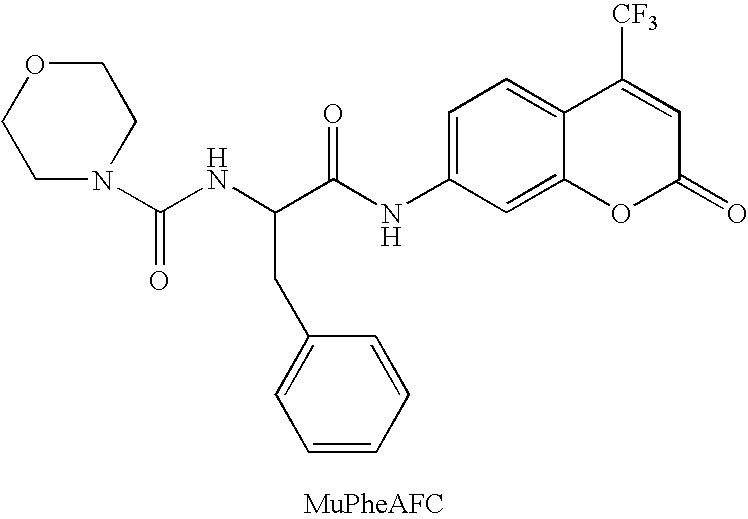Combinatorial screening of mixed populations of organisms
a technology of organisms and mixed populations, applied in the field of gene library screening and identification, can solve the problems of organisms that are difficult or impossible to culture for screening or re-supply, synthesis and development of lead compounds, and the current available methods for screening and producing lead compounds cannot be applied efficiently to these under-explored resources
- Summary
- Abstract
- Description
- Claims
- Application Information
AI Technical Summary
Benefits of technology
Problems solved by technology
Method used
Image
Examples
example 1
[0318]DNA isolation. DNA is isolated using the IsoQuick Procedure as per manufacture's instructions (Orca Research Inc., Bothell, Wash.). The isolated DNA can optionally be normalized according to Example 2 (below). Upon isolation, the DNA is sheared by pushing and pulling the DNA through a 25-gauge doublc-hub needle and a 1-cc syringe about 500 times. A small amount is run on a 0.8% agarose gel to make sure the majority of the DNA is in the desired size range (about 3-6kb).
[0319]Blunt-ending DNA. The DNA is blunt-ended by mixing 45 μl of 10× Mung Bean Buffer, 2.0 μl Mung Bean Nuclease (1050 u / μ) and water to a final volume of 405 μl. The mixture is incubated at 37° C. for 15 minutes. The mixture is phenol;chloroforrn extracted, followed by an additional chloroform extraction. One ml of ice cold ethanol is added to the final extract to precipitate the DNA. The DNA is precipitated for 10 minutes on ice. The DNA is removed by centrifugation in a microcentrifuge for 30 minutes. The pel...
example 2
Normalization
[0336]Prior to library generation, purified DNA can be normalized. DNA is first fractionated according to the following protocol A sample composed of genomic DNA is purified on a cesium-chloride gradient. The cesium chloride (Rf=1.3980) solution is filtered through a 0.2 μm filter and 15 ml is loaded into a 35 ml OptiSeal tube (Beckman) The DNA is added and thoroughly mixed. Ten micrograms of bis-benzimide (Sigma; Hoechst 33258) is added and mixed thoroughly. The tube is then filled with the filtered cesium chloride solution and spun in a Bti50 rotor in a Beckman L8-70 Ultracentrifuge at 33 k rpm for 72 hours. Following centriflgation, a syringe pump and fractionator (Brandel Model 186) are used to drive the gradient through an ISCO UA-5UV absorbance detector set to 280 nm. Peaks representing the DNA from the organisms present in an environmental sample are obtained. Eubacterial sequences can be detected by PCR amplification of DNA encoding rRNA from a 10 fold dilution ...
example 3
Enzymatic Activity Assay
[0339]The following is a representative example of a procedure for screening an expression library, prepared in accordance with Example 1, for hydrolase activity.
[0340]Plates of the library prepared as described in Example 1 are used to multiply inoculate a single plate containing 200 μl of LB Amp / Meth, glycerol in each well. This step is performed using the High Density Replicating Tool (HDRT) of the Beckman BIOMEK.RTM. with a 1% bleach, water, isopropanol, air-dry sterilization cycle between each inoculation. The single plate is grown for 2 h at 37° C. and is then used to inoculate two white 96-well DYNATECH microtiter daughter plates containing 250 μl of LB Amp / Meth, glycerol in each well. The original single plate is incubated at 37° C. for 18 h, then stored at −80° C. The two condensed daughter plates are incubated at 37° C. also for 18 h. The condensed daughter plates are then heated at 70° C. for 45 min. to kill the cells and inactivate the host E. col...
PUM
| Property | Measurement | Unit |
|---|---|---|
| Volume | aaaaa | aaaaa |
| Volume | aaaaa | aaaaa |
| Volume | aaaaa | aaaaa |
Abstract
Description
Claims
Application Information
 Login to View More
Login to View More - R&D
- Intellectual Property
- Life Sciences
- Materials
- Tech Scout
- Unparalleled Data Quality
- Higher Quality Content
- 60% Fewer Hallucinations
Browse by: Latest US Patents, China's latest patents, Technical Efficacy Thesaurus, Application Domain, Technology Topic, Popular Technical Reports.
© 2025 PatSnap. All rights reserved.Legal|Privacy policy|Modern Slavery Act Transparency Statement|Sitemap|About US| Contact US: help@patsnap.com


